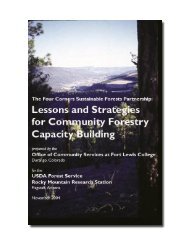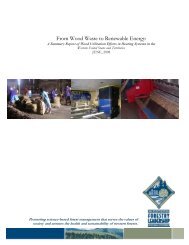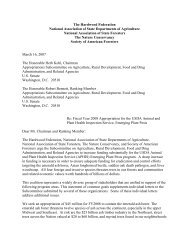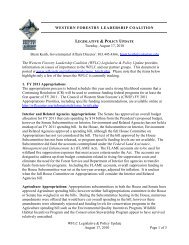Emission Controls for Small Wood-Fired Boilers - Western Forestry ...
Emission Controls for Small Wood-Fired Boilers - Western Forestry ...
Emission Controls for Small Wood-Fired Boilers - Western Forestry ...
You also want an ePaper? Increase the reach of your titles
YUMPU automatically turns print PDFs into web optimized ePapers that Google loves.
Table 7 shows approximate PM2.5, PM10 and PM control efficiency <strong>for</strong> the five sites. 1 The control<br />
efficiencies listed below refer to the percent of filterable particulate matter removed by the add‐on<br />
pollution control device. Control efficiencies <strong>for</strong> different add‐on pollution controls are further discussed<br />
later in this report.<br />
Table 7: Vermont ANR <strong>Emission</strong> Study Approximate Control Efficiencies<br />
Location<br />
PM Control<br />
PM2.5<br />
Control<br />
Efficiency<br />
PM10<br />
Control<br />
Efficiency<br />
PM Control<br />
Efficiency<br />
Greenfield, NH Multicyclone + baghouse 74% 74% 83%<br />
Bennington, VT Two multicyclones in series 14% 22% 61%<br />
Brattleboro, VT Core separator (24”) 24% 32% 60%<br />
North Scituate, RI High efficiency multicyclone 15% 21% 23%<br />
Hinesburg, VT Cyclone 3% 6% 4%<br />
The following observations were made from these results:<br />
• Bennington and Brattleboro, VT. The PM control efficiencies are typically significantly higher<br />
than the PM2.5 and PM10 efficiencies because there were significant quantities of particles<br />
larger than PM10 (ten microns in aerodynamic diameter) emitted during the stack tests.<br />
• Greenfield, NH. The control efficiency is relatively low <strong>for</strong> a multicyclone followed by a<br />
baghouse. Baghouses are widely thought to achieve 99% control efficiency <strong>for</strong> PM2.5 and smaller<br />
filterable particles. As mentioned, the low control efficiency is suspected to be due to a portion of<br />
the boiler exhaust gases circumventing the bag house via a damper which was not closed<br />
completely. This allowed a small portion of the boiler exhaust into a bypass duct around the<br />
baghouse and into the stack.<br />
• Bennington, VT. While this is the highest control efficiency value of all mechanical collectors<br />
tested, the actual emissions were higher than all other five sites (0.382 <strong>for</strong> PM10 and 0.267<br />
lb/MMBtu <strong>for</strong> PM2.5). The higher emissions may be due to carry over of large particles from the<br />
combustion chamber caused by pneumatic feeding of fuel into the combustion chamber.<br />
It was discovered after this testing that some of the underfire air passages were obstructed by a<br />
buildup of boiler bottom ash. This ash was subsequently cleaned out, the boiler combustion air<br />
was adjusted and an improved ash management procedure was implemented. The retesting<br />
which occurred after these measures were implemented indicated the total PM emission rate<br />
dropped to 0.14 lb/MMBtu (approximately a 63% reduction).<br />
• Brattleboro, VT. The PM collection efficiency was nearly the same as at Bennington, but the<br />
PM10 and PM2.5 collection efficiencies were higher. This shows the Core Separator is more<br />
effective at removing smaller particles than conventional multicyclones, even conventional<br />
multicyclones in series.<br />
The Core Separator operating at Brattleboro was designed <strong>for</strong> the exhaust volume from a 400<br />
horsepower (hp) boiler. However, the boiler size was reduced to 332 hp during project<br />
development. So while a smaller “2‐core” unit would have worked, a “3 core” unit was operating.<br />
The result is that during emission testing, the Core Separator was operating at half it's design<br />
pressure drop. A higher collection efficiency would likely have resulted if it was operating at its<br />
design pressure drop.<br />
1<br />
The PM2.5 and PM10 control efficiencies were calculated using the inlet and outlet emission factors (in lb/MMBtu) from the control<br />
device. The PM control efficiency was taken directly from the study report.<br />
Resource Systems Group, Inc.<br />
<strong>Emission</strong> Control Technologies <strong>for</strong> <strong>Small</strong> <strong>Wood</strong>‐<strong>Fired</strong> <strong>Boilers</strong><br />
6 May 2010 Page 8










